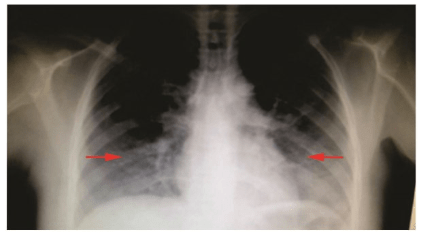1. EL Fane M, Sodqi M, Oulad Lahsen A, et al. Pneumocystosis during HIV infection. Rev Pneumol Clin. 2016; 72(4): 248-254. doi: 10.1016/j.pneumo.2016.04.004
2. Goodnight WH, Soper DE. Pneumonia in pregnancy. Crit Care Med. 2005; 33(10 Suppl): S390-S397. doi: 10.1097/01.CCM.0000182483.24836.66
3. Tamaki Y, Higa F, Tasato D, et al. Pneumocystis jirovecii pneumonia and alveolar haemorrhage in a pregnant woman with human T cell lymhotrophic virus type-1 infection. Intern Med. 2011; 50(4): 351-354. doi: 10.2169/internalmedicine.50.4482
4. Ahmad H, Mehta NJ, Manikal VM, et al. Pneumocystis carinii pneumonia in pregnancy. Chest. 2001; 120(2): 666-671. doi: 10.1378/chest.120.2.666
5. Fitzpatrick M, Brooks JT, Kaplan JE. Epidemiology of HIVAssociated Lung Disease in the United States. Semin Respir Crit Care Med. 2016; 37(2): 181-198. doi: 10.1055/s-0036-1572556
6. Cailliez JC, , Séguy N, Denis CM, et al. Pneumocystis carinii: An atypical fungal micro-organism. J Med Vet Mycol. 1996; 34(4): 227-239. Web site. http://www.tandfonline.com/doi/abs/ 10.1080/02681219680000401?journalCode=immy19. Accessed August 29, 2016
7. Albino JA, Shapiro JM. Respiratory failure in pregnancy due to Pneumocystis carinii: Report of a successful outcome. Obstet Gynecol. 1994; 83(5 Pt 2): 823-824. Web site. http://europepmc.org/abstract/med/8159362. Accessed August 29, 2016
8. Minkoff H, deRegt RH, Landesman S, Schwarz R. Pneumocystis carinii pneumonia associated with acquired immunodeficiency syndrome in pregnancy: A report of three maternal deaths. Obstet Gynecol. 1986; 67(2): 284-287. Web site. http://journals.lww.com/greenjournal/abstract/1986/02000/pneumocystis_carinii_pneumonia_associated_with.24.aspx. Accessed August 29, 2016
9. Curtis M, Patel A, Degeyter K, Neitzschman H. Radiology of the month: Spontaneous Bilateral pneumothoraces in an hivinfected patient. J La State Med Soc. 2016; 168(3): 120-121.
10. Galstian GM, Novikov VA, Troitskaia VV, et al. Lung ultrasonography for the diagnosis of pneumonia in pregnant women with blood system tumors. Ter Arkh. 2015; 87(1): 79-87. Web site. http://europepmc.org/abstract/med/25823274. Accessed August 29, 2016
11. van Halsema C, Johnson L, Baxter J, et al. Short communication: Diagnosis of pneumocystis jirovecii pneumonia by detection of DNA in blood and oropharyngeal wash, compared with sputum. AIDS Res Hum Retroviruses. 2016; 32(5): 463-466. doi: 10.1089/AID.2015.0213
12. Church JA, Fitzgerald F, Walker AS, Gibb DM, Prendergast AJ. The expanding role of co-trimoxazole in developing countries. Lancet Infect Dis. 2015; 15(3): 327-339. doi: 10.1016/ S1473-3099(14)71011-4
13. Connelly RT, Lourwood DL. Pneumocystis carinii pneumonia prophylaxis during pregnancy. Pharmacotherapy. 1994; 14(4): 424-429. doi: 10.1002/j.1875-9114.1994.tb02832.x
14. Forna F, McConnell M, Kitabire FN, et al. Systematic review of the safety of trimethoprim-sulfamethoxazole for prophylaxis in HIV-infected pregnant women: Implications for resourcelimited settings. AIDS Rev. 2006; 8(1): 24-36.
15. Sarti GM. Aerosolized pentamidine in HIV. Promising new treatment for Pneumocystis carinii pneumonia. Postgrad Med. 1989; 86(2): 54-69. doi: 10.1080/00325481.1989.11704352
16. Gates HS Jr, Barker CD. Pneumocystis carinii pneumonia in pregnancy: A case report. J Reprod Med. 1993; 38(6): 483-486. Web site. http://europepmc.org/abstract/med/8331631. Accessed August 29, 2016
17. Kurennaia SS , Shlopov VG , Mirovich DIu , Demina TN, Berko AT. Pneumocystosis in a pregnant patient complicated by transplacental infection and intrauterine fetal death. Akush Ginekol. 1985; (4): 72-73. Web site. http://europepmc.org/abstract/med/3159302. Accessed August 29, 2016
18. Pavlica F. The first observation of congenital pneumocystic pneumonia in a fully developed stillborn child. Ann Paediatr1962; 198: 177-184. Web site. http://europepmc.org/abstract/med/14484595. Accessed August 29, 2016
19. Mortier E, Pouchot J, Bossi P, Molinie V. Maternal-fetal transmission of Pneumocystis carinii in human immuno deficiency virus infection. N Engl J Med. 1995; 332(12): 825. doi: 10.1056/NEJM199503233321219






